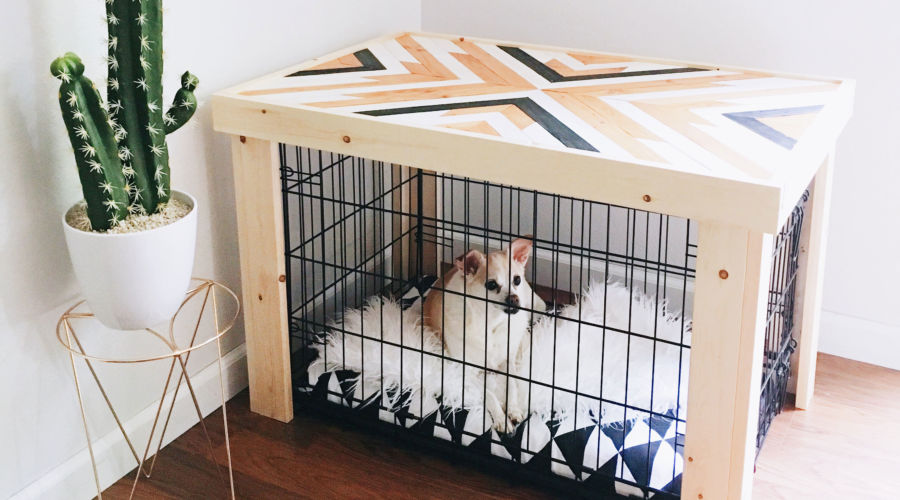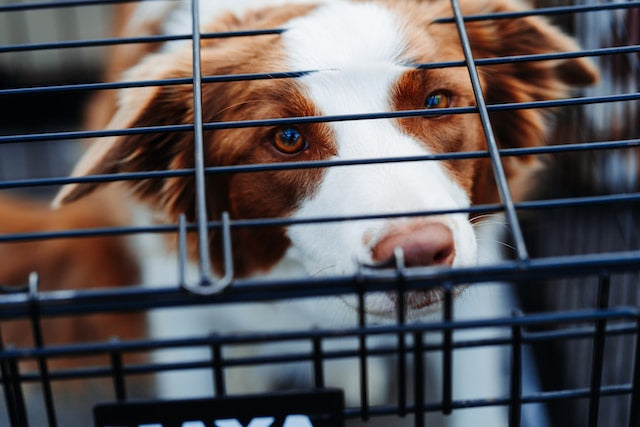Crate Training an Anxious Dog: Overcoming Challenges and Fears
Whether you're welcoming a new puppy or an older dog to your home, creating a safe and structured environment for your dog is essential. As a pet parent, you're surely familiar with the myriad benefits of crate training, which provides just what you need to build a cozy home for your pet. In this article, we'll delve into specialized techniques that will help you build the perfect program to crate train a dog with separation anxiety, ensuring they feel safe and calm when you're not by their side.
How to crate train a dog with separation anxiety
To crate train a dog with separation anxiety, we suggest structuring your training procedure into 5 steps:
- Find the right crate and make it appealing.
- Get your dog familiarized with the crate.
- Calmly leave and return.
- Use verbal commands and departure cues.
- Switch up your training.
1. Find the right crate and make it appealing

One of the most important factors for successfully crate training your dog is having the right crate. Consider this: your dog will spend a significant amount of time in the crate. Thus it should be your top priority to make sure the crate is as comfortable and inviting to your dog as possible. This will help them develop positive associations with the crate, which can greatly expedite the process.
Crate size & material
It's very important to choose a crate with the right size for your pup. It means there should be enough space for them to stand, turn around, lie down, and stretch their legs without anything blocking their way.
Mesh and wire crates are particularly popular among pet parents that are crate training their dogs for the first time. The only downside is that if your dog shows destructive behavior, chances are they might chew through the crate since these materials are quite lightweight. Perhaps, a more durable material such as steel would be a better option here. Make sure the crate has proper ventilation to maintain airflow.
Set up the crate
Make the crate appealing to your dog. Add a dog bed or blanket to make the crate cozy. Don't forget to toss in some of your dog's favorite toys, treats, and a bowl of water. Chew toys or puzzle toys are a solid option. They'll provide the mental stimulation needed to keep your dog occupied in the crate.
Finally, place the crate in a quiet corner of your house. Loud noises and movements can be distracting and heighten your dog's stress. Avoid places such as the door, living room, or kitchen.
2. Get your dog familiarized with the crate

Desensitization
It's time to introduce your dog to their crate! We recommend using desensitization, a method that involves exposing your pup to a trigger at an exceptionally low level, then slowly ramping up the intensity of the exposure. This is a widely used practice in dog training as it has proven successful.
This is how it's done: First, let your dog have a chance to sniff around the crate. Once they're comfortable enough, encourage them to go inside.
It's important to leave the crate door open in the beginning. This will give them the freedom to exit the crate whenever they want to. Having the crate door closed too early can startle your dog and make them anxious.
Once your dog grows more familiar with the crate, shut the door for a few seconds and move away from the crate. Be sure to maintain being within your dog's vision. By doing this, your dog learns that just because they're crated, it doesn't mean they are left alone. They will also come to realize that you'll eventually come back to them every time you leave, which helps ease their separation anxiety.
Be extra generous with treats here, particularly the high value ones, as they can be a great motivator! Toss your pup a treat once you come back to reward them for good behavior.
Be patient
If your dog shows no negative reaction to this, you should gradually increase their crate time. It shows that they're starting to perceive the crate as a safe space, which is a great sign. However, if your dog starts crying or getting anxious, it signifies that they are not yet used to their crate. You should slow down and spend more time at this step. For an adult dog, this might take longer than a couple of days. Remain patient!
3. Calmly leave and return

After your dog begins showing comfort around the crate, you can start leaving them inside for longer periods. Just a quick note, try not to make a big deal out of when you leave or come back. Remain composed as if it's not a major event.
To help your dog overcome their separation anxiety, you need to make them think that your departure and return are just part of a regular routine. Showing too much excitement or enthusiasm when seeing your dog can make them think that your being back home is a significant occurrence as if you did not at all expect to come back after leaving them. Thus, try to remain calm so you don't spike your dog's anxiety.
Better yet, you may leave your dog in the crate for some time after you get home. Casually let them out of the crate when you feel like it's the right time.
4. Use verbal commands and departure cues

Giving your dog a verbal heads-up when you're about to leave or when you return can help ease their separation anxiety. These commands can be as simple as "I'm leaving" or "I'm home!" Notifications like these help your dog understand that after you go away, you will eventually come back by associating the first command with the second command. Say these commands when your dog is already in the crate.
Additionally, practice your departure cues such as grabbing your keys or putting on shoes in front of your dog, while they're in the crate. Wait a couple of minutes before putting those items away, and going back to normal. Slowly add one cue after another, and increase the wait time. You can even try going to another room in your house after picking up your things. The trick is to get your dog slowly build up tolerance towards the signs of your departure by using desensitization.
5. Switch up your training
Don't be afraid to mix up the time of your departure and return. This can help prevent your dog from expecting your absence or presence at a certain time of the day, which can lead to more anxiety. Go about your life and leave the house when you need to, anytime during the day.
If there's another family member, make sure they participate in the crate training as well. Take turns leaving your dog, or leave together at the same time. Your dog will learn to stay calm no matter who is leaving.

Tips on how to crate train a dog with separation anxiety
Keep your dog active
Never downplay the importance of daily exercise when crate training a dog with separation anxiety! Your dog may have a lot of pent-up energy that makes them more likely to get anxious. Take them out for runs and walks, play a round of fetch, or tug-a-war. This will tire out your dog and they won't protest as much when you leave.
Don't leave your dog in the crate all day long
Pay close attention to how long you can leave a dog in the crate. Depending on your dog's age, they can be left in a crate between 30 minutes and 8 hours. Always take them out for a potty break before and after you crate them for long durations.
Never punish your dog for anxious behaviors
Be extra gentle when training a dog with separation anxiety. Don't use the crate as a form of punishment. Always strive to make your dog regard the crate as a safe, positive place.
Change your dog's routine
Sometimes you don't need to teach an old dog new tricks. You can help mold your dog's behavior simply by modifying their schedule. That includes more exercise, longer walks, additional playtime, or new toys or treats.
What if my dog exhibits extreme stress?

It's normal for a dog with separation anxiety to show frustration during the training process. Understand that this is as difficult for your dog as well as it is for you. Furthermore, it's undoubtedly a long process. For a senior dog, it could even take months. That's why being patient is paramount.
Speak to your vet if your dog continues to show a high level of anxiety. They can prescribe medications that can help alleviate your dog's stress. You may include calming treats or CBD oils in your training, which have a calming effect and can tame your dog's anxiety when necessary.
Separation anxiety - a frequent challenge among dogs
Historically, it was common to think that separation anxiety impacted mostly shelter dogs. The reason is that rescue dogs are more likely to experience traumas in the past. These experiences include abandonment, abuse, or drastic changes in the household. Given such instability in their past life, shelter dogs are more prone to feeling anxious when being left alone by their owners.
COVID-19 impact
However, there has been an increasing number of other dogs that experience separation anxiety when being by themselves. The COVID-19 lockdown, which sent millions working from home for the last few years, has had an imminent affect on this. Many dogs are so accustomed to their pet parents being around all the time, they get a panic attack the moment their owner steps away, even just for short periods.
With many people returning to the office, the problem of separation anxiety has become even more prevalent. Training anxious dogs is a tough gig. Thus, investing time and effort into the proper training is crucial to help your pup effectively manage their anxiety.
Final thoughts
No matter how we put it, crate training a dog with separation anxiety is a lengthy process that requires time and patience. There's a lot to learn to effectively crate train your dog, but it's essential not to rush through the process. Taking baby steps to understand your dog's threshold, what they like and do not like, and to figure out the optimal routine, is totally necessary and worthwhile. If things get tricky, don't sweat it, consider reaching out to a professional trainer or a behaviorist for crate training help. Best of luck!




